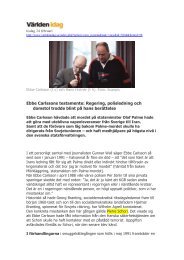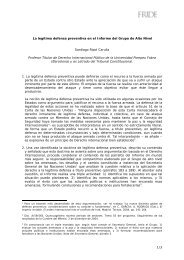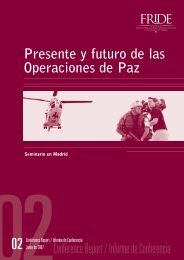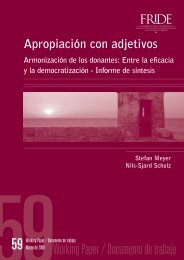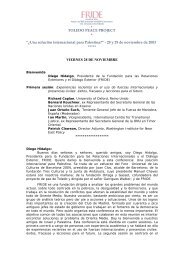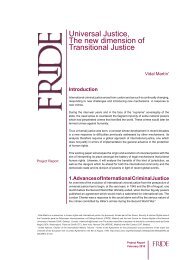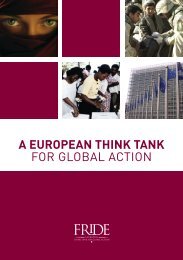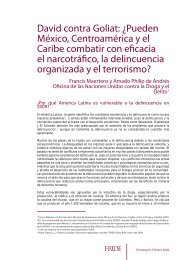Sierra Leone: Reconstructing a Patrimonial State - Fride
Sierra Leone: Reconstructing a Patrimonial State - Fride
Sierra Leone: Reconstructing a Patrimonial State - Fride
You also want an ePaper? Increase the reach of your titles
YUMPU automatically turns print PDFs into web optimized ePapers that Google loves.
3<br />
socialist rhetoric was marshalled, <strong>Sierra</strong> <strong>Leone</strong> was<br />
always sympathetic to the West. Consequently, aid<br />
finance was deployed, replacing domestic state<br />
services rather than building capacities. 4<br />
multi-party constitution re-established formal<br />
democracy, the state was left a hollow shell and was<br />
soon to loose even the alleged control over the<br />
territory.<br />
After independence, constant state decline followed.<br />
In the first elections, the <strong>Sierra</strong> <strong>Leone</strong> peoples party<br />
SLPP won. They soon instated a heavily biased<br />
system of rule highly favourable towards their<br />
Southern constituencies. When in 1967 Siaka<br />
Stevens from the All Peoples Congress APC was<br />
elected president by a very narrow margin he was<br />
expelled from office days later by a military coup.<br />
Soon, after he was reinstated and, with that, the<br />
successive process of de-institutionalisation was<br />
continued. The rigging of elections in 1973, the<br />
abolition of the constitution in 1976 and its<br />
replacement by a one-party system, the elimination of<br />
the decentralised governance structure, the<br />
suppression of student revolts in 1977 and the<br />
increasingly authoritarian control of the party were<br />
the landmarks in which was to end up in a neopatrimonial<br />
system in which every handling of stateresources<br />
was grouped around the fellowship to the<br />
president. The withdrawal of the state from any kind<br />
of service provision culminated in the declaration of<br />
the then president Joseph Saidu Momoh in 1988<br />
where he said education is a privilege not a right. 5<br />
While the state was able to raise 15% of GDP in<br />
taxes in the period 1974-82, it had fallen to a mere<br />
5% between 1983-91. 6 When, in September 1991, a<br />
4 Deborah Bräutigam (2000), Aid Dependence and Governance,<br />
Stockholm (EGDI); describes how aid agencies – namely the<br />
European Commission, the German GTZ and the Word Bank carved<br />
out their respective territories in the 1970s.<br />
http://www.egdi.gov.se/pdf/20001pdf/2000_1.pdf<br />
5 Steven Archibald and Paul Richards (2002), ‘Converts to<br />
Human Rights? Popular Debate about War and Justice in Rural<br />
Central <strong>Sierra</strong> <strong>Leone</strong>’, Africa, 72, 2002.<br />
6 Deborah Bräutigam (2000), Aid Dependence and Governance,<br />
Stockholm (EGDI), p. 22. http://www.egdi.gov.se/pdf/ 20001pdf/<br />
2000_1.pdf<br />
The March 1991 attack on <strong>Sierra</strong> <strong>Leone</strong> territory by<br />
a mixed guerrilla group, composed by <strong>Sierra</strong> <strong>Leone</strong>an,<br />
Liberians and Burkinabe, started the ten year civil<br />
war. For the then government in Freetown it seemed<br />
a matter of little concern in a remote place where<br />
government did no reach anyway. It soon was to<br />
spread out and reached Freetown finally in 1997,<br />
when rebels invaded large parts of the capital.<br />
Between 1991 and 2002, various fighting forces<br />
clashed. Amongst these were 7<br />
• Revolutionary United Front (RUF): initially a blend<br />
of urban intellectuals inspired by Marxism, Pan-<br />
Africanism and Libyan Green Book ideology and<br />
army mutineers, they were soon joined by rural<br />
youths.<br />
Whereas ideological motivation was<br />
eminent in forming the movement, during the cause<br />
of the war intellectual leaders were eliminated and<br />
in the last phase of the war a millenarian attitude<br />
justified gross abuse and exploitation of the rural<br />
population. As of 1992 Foday Sankoh was the<br />
leader. The RUF became to be known as one of the<br />
most brutal African guerrilla groups, amputating<br />
rural villagers and abducting children to turn them<br />
into fighters. The report of the Truth and<br />
Reconciliation Commission finds them responsible<br />
for over 60 percent of the atrocities. The RUF had<br />
been aided by Charles Taylor from Liberia.<br />
7 The fighting forces and the atrocities that are ascribed to them<br />
are documented in the report of the <strong>Sierra</strong> <strong>Leone</strong> Truth and<br />
Reconciliation Commission 2004, Witness to Truth, Freetown, Vol. 2;<br />
Chapter 2, Findings, paragraph ‘findings of perpetrator responsibility’,<br />
pp. 41 – 83, www.trcsierraleone.org<br />
<strong>Sierra</strong> <strong>Leone</strong>: <strong>Reconstructing</strong> a <strong>Patrimonial</strong> <strong>State</strong> May 2007



